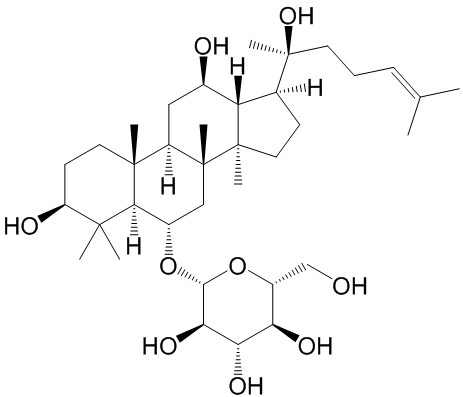Home
Products
Ginsenoside Rh1



| Product Name | Ginsenoside Rh1 |
| Price: | $62 / 20mg |
| Catalog No.: | CN08036 |
| CAS No.: | 63223-86-9 |
| Molecular Formula: | C36H62O9 |
| Molecular Weight: | 638.88 g/mol |
| Purity: | >=98% |
| Type of Compound: | Triterpenoids |
| Physical Desc.: | Powder |
| Source: | The roots of Panax ginseng C. A. Mey. |
| Solvent: | DMSO, Pyridine, Methanol, Ethanol, etc. |
| SMILES: | OC[C@H]1O[C@@H](O[C@H]2C[C@]3(C)[C@@H]([C@@]4([C@@H]2C(C)(C)[C@@H](O)CC4)C)C[C@H]([C@H]2[C@@]3(C)CC[C@@H]2[C@](CCC=C(C)C)(O)C)O)[C@@H]([C@H]([C@@H]1O)O)O |
| Contact us | |
|---|---|
| First Name: | |
| Last Name: | |
| E-mail: | |
| Question: | |
| Description | Ginsenoside Rh1 is isolated from the root of Panax Ginseng. Ginsenoside Rh1 inhibits the expression of PPAR-γ, TNF-α, IL-6, and IL-1β. |
| Target | PPAR-γ TNF-α IL-6 IL-1β |
| In Vitro | The effect of Ginsenoside Rh1 is examined on adipogenesis in 3T3-L1 cells. Ginsenoside Rh1 potently inhibits the adipogenesis, as assessed by Oil-red O staining and lipid contents in 3T3-L1 adipocytes. Ginsenoside Rh1, at concentrations of 50 μM and 100 μM, inhibit the adipogenesis by 50% and 63%, respectively.The expression levels of adipocytespecific genes such as PPAR-γ, C/EBP-α, FAS, aFABP and some genes are examined during early phase of differentiation such as Pref-1, C/EBP-δ and Glucocorticoid receptor (GR). After the treatment with Ginsenoside Rh1 in 3T3-L1 cells, mRNA is extracted on 18 h and 24 h for Pref-1, C/EBP-δ and GR and day 8 for PPAR-γ, C/EBP-α, FAS, aFABP. Then, the expression profiles of adipocyte-specific genes are investigated by RT-PCR. PPAR-γ, C/EBP-α, FAS, and aFABP expressions are significantly increased in DMI-stimulated differentiated adipocyte compared to those of non-stimulated adipocyte cells. However, treatment with DMI in the presence of Ginsenoside Rh1 significantly suppresses the expression levels of PPAR-γ, C/EBP-α, FAS, and aFABP in a dose- dependent manner, whereas the expression levels of Pref-1, C/EBP-δ and GR are not affected[1]. |
| In Vivo | When high-fat diet (HFD) fed mice for 8 weeks, body and epididymal fat weight gains are significantly increased compared to those of low-fat diet (LFD)-fed mice. However, when Ginsenoside Rh1 is treated in HFD-fed mice, body and epididymal fat weight gains are significantly decrease compared with those of the HFD-fed mice. TG, glucose, insulin, total cholesterol, and HDL levels in the blood are significantly increased in HFD-fed mice group compared to LFD-fed mice group. Treatment with Ginsenoside Rh1 in HFD-fed mice significantly lowers TG level alone[1]. |
| Cell Assay | Mouse embryo fibroblasts 3T3-L1 cells are incubated in DMEM, containing 10% FBS and 1% AB, at 37°C and 5.6% CO2 atmosphere. To induce differentiation, two days after confluence, preadipocytes (designated day 0) are cultured in the differentiation medium (DM), which is consisted of DMEM, 10% FBS, 1% AB, and DMI (0.28 unit/mL insulin, 0.5 mM Isobutylmethylxanthine and 1 μM Dexamethasone) for 2 d in the presence or absence of 50 μM and 100 μM of Ginsenoside Rh1, and switched to DM containing 10% FBS and 10 μg/mL insulin and then changed to DMEM medium with 10% FBS for every 2 d[1]. |
| Animal Admin | Mice[1] Male C57BL/6J mice are separated into 3 groups, LFD, HFD and HFDRh1. Each group is consisted of ten mice. LFD group fed LFD for 8 weeks. HFD group fed HFD for 8 weeks. HFDRh1 group fed HFD diet for 4 weeks and then simultaneously treated with HFD and 20 mg/kg/d Ginsenoside Rh1, which is orally administrated. Weight and food intake of mice are measured daily. After finishing treatment for 4 weeks, blood and epididymal fats are collected for further analysis. |
| Density | 1.2±0.1 g/cm3 |
| Boiling Point | 755.1±60.0 °C at 760 mmHg |
| Flash Point | 410.5±32.9 °C |
| Exact Mass | 638.439392 |
| PSA | 160.07000 |
| LogP | 3.74 |
| Vapour Pressure | 0.0±5.7 mmHg at 25°C |